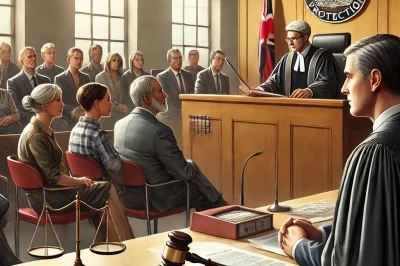Table of Contents

Key Takeaways
- The UK Court of Protection makes decisions for people who can’t make their own due to mental incapacity.
- It handles cases involving health, welfare, property, and financial affairs.
- Deputies can be appointed by the court to manage the affairs of individuals who lack capacity.
- The application process involves assessing mental capacity and submitting detailed documentation.
- Seeking professional legal advice can help navigate the complex procedures effectively.
Navigating the Maze: Understanding the UK Court of Protection
The UK Court of Protection is an essential institution for those who cannot make decisions for themselves due to mental incapacity. Understanding how this court operates can help you navigate its complexities more effectively. Let’s break it down step-by-step to make it easier to grasp.
Introduction to the Court of Protection
The Court of Protection was established to make decisions for individuals who lack the mental capacity to do so themselves. This can include decisions about their health, welfare, and financial matters. The court ensures that the rights and best interests of these individuals are safeguarded.
The Role and Purpose of the UK Court of Protection
The primary role of the Court of Protection is to make decisions on behalf of people who cannot make their own decisions. This might be due to conditions like dementia, learning disabilities, or brain injuries. The court steps in to protect these individuals and ensure their needs are met.
Core Functions of the Court
The Court of Protection has several key functions, each vital to its mission of safeguarding vulnerable individuals. These functions can be broadly categorized into three main areas: making decisions on health and welfare, managing property and financial affairs, and overseeing court-appointed deputies.
Making Decisions on Health and Welfare
One of the core functions of the Court of Protection is to make decisions about an individual’s health and welfare. This can include decisions about medical treatments, where the person should live, and what kind of care they should receive.
For instance, if there’s a disagreement among family members about the best course of medical treatment for a loved one who cannot decide for themselves, the Court of Protection can step in to resolve the issue. The court considers all relevant information and makes a decision that is in the best interests of the individual.
Managing Property and Financial Affairs
Besides health and welfare, the Court of Protection also manages the property and financial affairs of individuals who lack mental capacity. This can involve handling bank accounts, paying bills, managing investments, and even selling property if necessary.
Imagine a scenario where an elderly person with dementia can no longer manage their finances. The court can appoint a deputy to take over these responsibilities, ensuring that the person’s financial matters are handled properly and that their assets are protected.
Overseeing Court-Appointed Deputies
Deputies play a crucial role in the Court of Protection’s framework. These are individuals appointed by the court to make decisions on behalf of someone who lacks mental capacity. Deputies can be family members, friends, or professionals, depending on the circumstances.
The court closely oversees the actions of deputies to ensure they are acting in the best interests of the person they are representing. Deputies must submit regular reports to the court, detailing the decisions they have made and how they have managed the individual’s affairs. For more insights on navigating legal complexities, you can read Navigating the Maze.
Types of Cases Handled
The Court of Protection handles a wide range of cases, each with its own unique challenges. Some of the most common types of cases include financial abuse, disputes over medical treatment, and disagreements about living arrangements. Understanding these different types of cases can help you better navigate the court’s processes.
Financial Abuse Cases
Financial abuse is a serious issue that the Court of Protection often addresses. This can involve situations where someone is exploiting a vulnerable person’s finances for their own gain. The court can step in to protect the individual’s assets and take legal action against the abuser.
For example, if an elderly person is being coerced into giving away large sums of money by a family member, the court can intervene. It can freeze the person’s accounts, appoint a deputy to manage their finances, and take steps to recover any lost funds.
Disputes Over Medical Treatment
Another common type of case involves disputes over medical treatment. These cases can arise when there is a disagreement about the best course of action for a person’s health care. The court can evaluate all the evidence and make a decision that prioritizes the individual’s well-being.
Consider a situation where doctors recommend a particular treatment for a patient who lacks capacity, but the family disagrees. The Court of Protection can step in to assess the situation, considering medical opinions and the patient’s best interests before making a ruling. Learn more about the consequences of not having in place a health and welfare LPA.
Application Process
Applying to the Court of Protection involves several steps, each requiring careful attention to detail. The process can be complex, but understanding it can make it more manageable. Here’s a breakdown of what you need to do.
First, you need to complete the relevant application forms. These forms can be found on the official UK government website. The main form you’ll need is the COP1 application form, which is used to start proceedings. Depending on your specific situation, you may need additional forms such as COP3 (assessment of capacity) and COP4 (deputy’s declaration). For more information on the importance of these forms, check out this guide on protecting your financial future.
- Fill out the COP1 form with details about the person who lacks capacity and the decisions that need to be made.
- Submit a COP3 form, which must be completed by a medical professional to confirm the person’s lack of capacity.
- If applying to be a deputy, complete the COP4 form, where you declare your suitability for the role.
After completing the forms, you must pay the application fee. As of now, the fee is £371, but it’s always a good idea to check the latest fees on the government website. Fee exemptions or reductions may be available for those who qualify.
Assessment of Mental Capacity
The assessment of mental capacity is a critical part of the application process. This assessment determines whether the individual can make their own decisions. The COP3 form, completed by a medical professional, provides the court with the necessary information to make this determination.
To complete the COP3 form, a qualified healthcare professional, such as a GP or psychiatrist, will evaluate the individual’s mental capacity. They will assess whether the person can understand, retain, and weigh the information needed to make a specific decision, and whether they can communicate their decision. For more insight, you can read about how the Court of Protection impacts families.
For example, if you’re applying to make financial decisions on behalf of a relative with dementia, the medical professional will assess whether your relative can understand financial information and the consequences of their decisions. This assessment is crucial as it forms the basis for the court’s decision-making. Learn more about protecting financial future benefits with an LPA.
Appointment of Deputies
Once the court determines that an individual lacks capacity, it may appoint a deputy to make decisions on their behalf. Deputies can be family members, friends, or professionals, and they are responsible for acting in the best interests of the person they represent.
To become a deputy, you must demonstrate that you are suitable for the role. This involves completing the COP4 form, where you declare your commitment to the responsibilities of a deputy. The court will consider factors such as your relationship with the person, your understanding of their needs, and your ability to manage their affairs. For more information on how the Court of Protection impacts families, you can read about complex decisions here.
After appointment, deputies must follow the court’s rules and guidelines. They are required to keep detailed records of their decisions and actions, and they must submit annual reports to the court. This oversight ensures that deputies act responsibly and in the best interests of the individual.
Appeals and Reviews
If you disagree with a decision made by the Court of Protection, you have the right to appeal. The appeal process involves submitting an application to the court, explaining why you believe the decision was incorrect and providing any supporting evidence.
It’s important to act quickly, as there are strict time limits for filing an appeal. Generally, you must submit your appeal within 21 days of the original decision. The court will review your application and decide whether to grant permission for the appeal to proceed.
Besides appeals, the Court of Protection also conducts regular reviews of its decisions and the actions of deputies. These reviews ensure that the court’s decisions remain appropriate and that deputies are fulfilling their duties effectively. If circumstances change, the court can adjust its orders to better suit the individual’s needs. For more information, you can read about navigating the maze of the UK Court of Protection.
Importance and Impact of the Court of Protection
The Court of Protection plays a vital role in safeguarding the rights and welfare of individuals who cannot make their own decisions. By making informed and fair decisions, the court ensures that these individuals receive the care and support they need.
For many families, the Court of Protection provides a sense of security, knowing that their loved ones are protected. The court’s oversight helps prevent financial abuse and ensures that medical and welfare decisions are made in the best interests of the individual.
“The Court of Protection is essential for protecting vulnerable adults, ensuring their rights are upheld and their needs are met.” – Legal Services Commission
Navigating the Maze: Understanding the Court of Protection
Safeguarding Vulnerable Adults
The primary mission of the Court of Protection is to safeguard vulnerable adults. This includes protecting them from financial abuse, ensuring they receive appropriate medical care, and making sure their living arrangements are suitable. For more information, you can read about protecting financial futures and the benefits of legal tools available.
For example, if an elderly person with dementia is being financially exploited by a caregiver, the court can intervene. It can appoint a deputy to manage the person’s finances and take legal action against the abuser. This intervention helps protect the individual’s assets and ensures they receive the care they need.
Balancing Rights and Best Interests
One of the key challenges for the Court of Protection is balancing the rights of individuals with their best interests. The court must consider the person’s wishes and feelings, as well as their rights to autonomy and independence, while also ensuring their safety and well-being.
This balance is achieved through careful consideration of all relevant factors. The court listens to the views of family members, medical professionals, and other stakeholders, and it makes decisions based on a thorough assessment of the individual’s needs and circumstances.
Challenges and Criticisms
Despite its important role, the Court of Protection faces several challenges and criticisms. These include issues related to time delays, bureaucracy, cost, and accessibility. Addressing these challenges is crucial for improving the court’s effectiveness and ensuring that it can fulfill its mission.
Time Delays and Bureaucracy
One of the most common criticisms of the Court of Protection is the time it takes to process cases. The court’s procedures can be lengthy and complex, leading to delays in decision-making. These delays can be frustrating for families and can impact the well-being of the individuals involved.
Besides that, the court’s bureaucracy can be overwhelming. The application process involves extensive paperwork and detailed documentation, which can be difficult for individuals to navigate without professional assistance. Simplifying these procedures and reducing bureaucracy could help improve the court’s efficiency.
Cost and Accessibility Issues
Another significant challenge is the cost of accessing the Court of Protection. Application fees, legal costs, and other expenses can add up, making it difficult for some families to afford the process. This can be particularly challenging for those with limited financial resources.
Additionally, the court’s accessibility is a concern. Understanding the court’s procedures and navigating the legal system can be daunting, especially for those without legal expertise. Providing more support and resources for individuals and families could help make the court more accessible to everyone. For more details on how the court impacts families, check out this article on how the Court of Protection impacts families.
Practical Tips for Navigating the Court
While the Court of Protection can be complex, there are practical steps you can take to navigate it more effectively. Here are some tips to help you through the process.
Seek Professional Legal Advice
One of the most important steps you can take is to seek professional legal advice. A solicitor with experience in Court of Protection cases can guide you through the process, help you complete the necessary forms, and represent you in court if needed.
Working with a solicitor can provide you with peace of mind and ensure that your application is handled correctly. They can also help you understand your rights and responsibilities, making the process less daunting.
- Find a solicitor who specializes in Court of Protection cases.
- Discuss your situation and get advice on the best course of action.
- Ensure all forms and documents are completed accurately.
Understand Your Rights and Responsibilities
Understanding your rights and responsibilities is crucial when dealing with the Court of Protection. This knowledge can help you make informed decisions and ensure that you are acting in the best interests of the person you are representing.
Prepare Thorough Documentation
Proper documentation is essential for a successful application to the Court of Protection. Ensure that all forms are completed accurately and that you have all the necessary supporting documents. This includes medical assessments, financial statements, and any other relevant information.
Having thorough documentation can help expedite the process and reduce the likelihood of delays. It also provides the court with a clear understanding of the situation, making it easier for them to make informed decisions.
Utilise Support Services
There are various support services available to help you navigate the Court of Protection. These services can provide valuable information, guidance, and assistance throughout the process. Utilizing these resources can make the experience less stressful and more manageable.
Support services can include charities, advocacy groups, and helplines that specialise in assisting individuals with Court of Protection cases. These organizations can offer practical advice, emotional support, and help with completing forms and gathering documentation. For more information on how these complex decisions can impact families, visit this detailed article.
Conclusion: The Future of the Court of Protection
The Court of Protection plays a vital role in safeguarding the rights and welfare of individuals who cannot make their own decisions. While it faces challenges, ongoing improvements and public input can help enhance its effectiveness and accessibility.
Improvements on the Horizon
Efforts are being made to address the challenges faced by the Court of Protection. These improvements aim to streamline processes, reduce bureaucracy, and make the court more accessible to individuals and families in need. For instance, understanding the role of attorneys can be crucial in navigating the system effectively.
For example, there are initiatives to simplify application forms and provide more online resources. These changes can help reduce the time and cost associated with accessing the court, making it easier for people to get the support they need.
The Role of Ongoing Public Input
Public input is crucial for the continued improvement of the Court of Protection. By sharing their experiences and feedback, individuals can help identify areas that need attention and suggest ways to enhance the court’s processes. For more insights, read about how the Court of Protection impacts families.
Engaging with advocacy groups, participating in consultations, and providing feedback to the court can all contribute to positive changes. This collaborative approach ensures that the court remains responsive to the needs of the people it serves. Learn more about how the Court of Protection impacts families.
Frequently Asked Questions (FAQ)
What Does the Court of Protection Do?
The Court of Protection makes decisions for individuals who lack the mental capacity to make their own decisions. This includes decisions about health, welfare, property, and financial affairs.
How Do I Apply to the Court of Protection?
To apply to the Court of Protection, you need to complete the relevant forms (such as COP1, COP3, and COP4) and submit them along with the application fee. You may also need to provide supporting documents, such as medical assessments and financial statements.
It’s advisable to seek professional legal advice to ensure that your application is completed accurately and thoroughly.
What is a Deputy and How Are They Appointed?
A deputy is an individual appointed by the Court of Protection to make decisions on behalf of someone who lacks mental capacity. Deputies can be family members, friends, or professionals.
To become a deputy, you must complete the COP4 form and demonstrate your suitability for the role. The court will review your application and decide whether to appoint you as a deputy.
How Long Does a Typical Case Take?
The time it takes to process a case can vary depending on the complexity of the situation.
On average, it can take several months for the court to make a decision.
Delays can occur due to incomplete documentation or other factors.
Seeking professional legal advice can help expedite the process
- Probate in the UK Explained: Swansea Legal Solutions ‘Step-by-Step Guide for Executors – 1 January 2026
- Avoiding Probate Pitfalls: The Most Common UK Mistakes and How to Steer Clear of Them – 28 December 2025
- Simplifying Settlement Agreements: Swansea Legal Solutions’ Expertise in the Education and Healthcare Sectors – 28 December 2025






